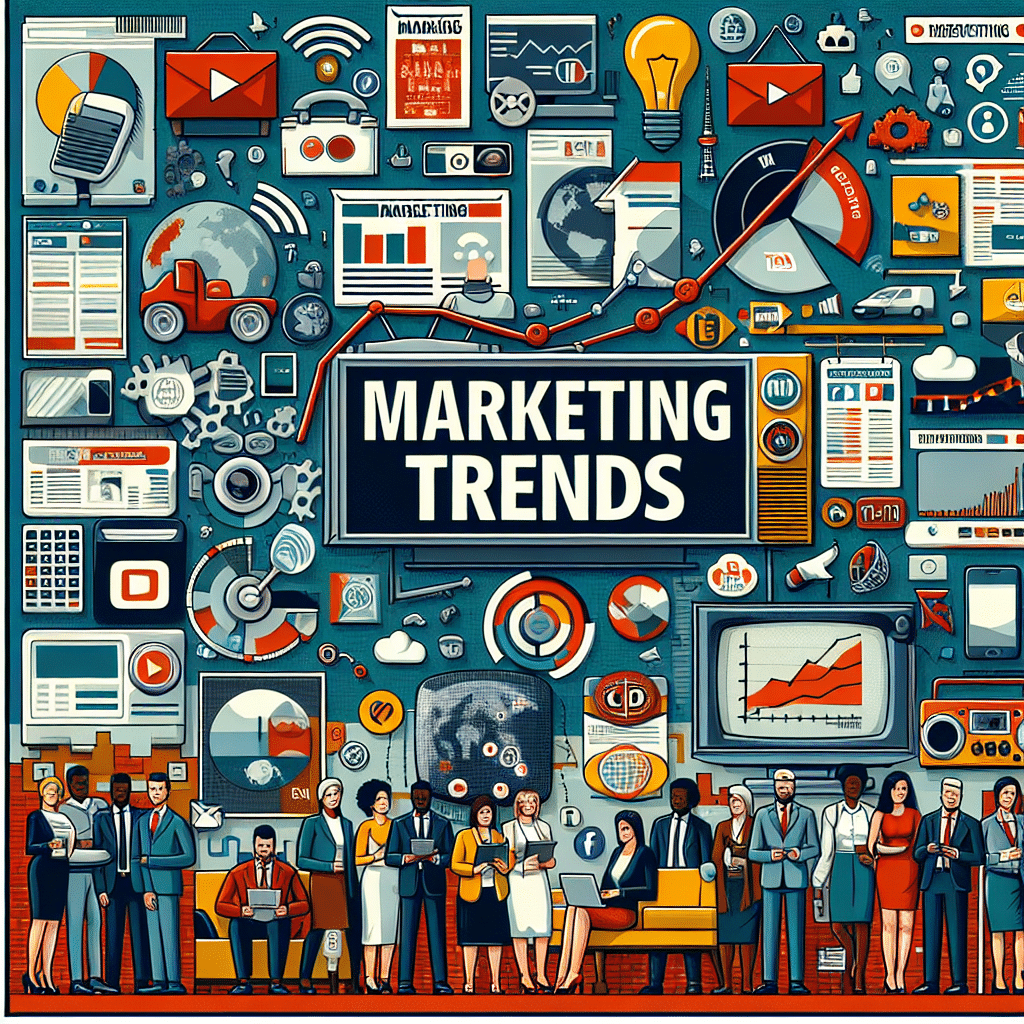Imagine a library with only a couple of books.
Would you call that a library? Absolutely not.
No one would be drawn to this library, let alone refer to it as such. Similarly, a brand that produces content sporadically can only partially leverage the benefits of content marketing. That is where content scaling comes into play.
There is no doubt that content is a critical driver of sales. For B2B brands, effective content marketing generates leads by demonstrating expertise and building trust – and according to Content Marketing Institute, 45% of B2B companies plan to increase their content marketing budget in the next year.
In B2C, content is a crucial touchpoint for engaging consumers and driving conversions. The more frequently and deeply consumers engage with a brand’s content, the more likely they are to purchase, underscoring the power of a robust content strategy.
Of course, if you want to be a significant and unique library, you shouldn’t just create any library; you should make a niche library tailored to serve your sales. Each piece of content should add value to the consumer’s journey, helping them understand why a particular brand or product is worth their time and money.
And how will you do that?
By content scaling, of course.

Every content strategy should determine how to deliver high-quality content that resonates with its audience. By consistently providing valuable, relevant content, brands can forge a stronger connection with their customers, turning casual visitors into loyal fans and advocates.
A commitment to creating a great library of quality content your audience loves will pay back in numerous ways. Not only does it enhance your SEO and improve your brand’s visibility online, but it also establishes your brand as a thought leader in your industry. This, in turn, builds greater trust with your audience, which is crucial for long-term relationships and customer retention.
Today, we will give you actionable tips for creating a rich, extensive library of quality content that consistently engages, educates, and entertains your audience.
Keep on reading to find out how content scaling will benefit your business.
What is content scaling?
As the name implies, content scaling involves creating a diverse and extensive content library. Of course, it is not just producing high amounts of quality SEO content but also the distribution of it.
It is a strategic approach that demands detailed planning to map out content in different distribution channels according to various stages of the customer journey, audience needs, and business goals.
Content scaling is especially critical for maintaining a competitive edge in digital marketing. As demand for informative and engaging content grows every day, every brand should leverage the power of content scaling to stay relevant and visible in a crowded digital landscape. Your content scaling strategy will determine your brand’s reach, engagement, and visibility.
By consistently delivering valuable content, your brand can strengthen its connection with its audience, establish thought leadership, drive meaningful conversions, and stay on top of its game.
Why is Content Scaling Important?
Content scaling is a critical strategy for any business looking to thrive digitally. It maximizes content’s reach and impact while maintaining quality and relevance. It is crucial for staying competitive and relevant in an increasingly content-driven marketplace.
You should be aware that content scaling doesn’t just support one aspect of marketing but bolsters several goals, including lead generation, customer education, brand awareness, and customer loyalty. Scaling content ensures that these goals are met more effectively and cohesively.
Here are several key reasons to implement a content scaling strategy:
Enhanced SEO performance

The more content you produce, the more chances you have to include keywords, answer common queries, and appear in search results. Search engines will index you more. This can improve organic search rankings and drive more traffic to your site.
Continuing to produce content regularly enriches your site. It signifies to search engines that your website is a dynamic and valuable resource. This consistent addition of new content can significantly enhance your position on the search engine results pages (SERPs), making it more likely that potential customers will find you when searching for relevant topics.
Reaching a wider audience
You will engage with a broader spectrum of potential customers by producing more content. Each piece of content can attract viewers from different demographics or interest groups. This increases your brand’s visibility across various platforms and helps tap into new market segments and potential customers.
For example, you can create specific content that appeals to young professionals. At the same time, other pieces might be geared toward retirees or families. This targeted approach boosts engagement by resonating more deeply with different groups, increasing the likelihood of your content being shared within those communities.
By reaching a wider audience, you’re not just broadcasting your message; you’re also listening and learning. Each interaction with your content provides valuable consumer preferences, behaviors, and feedback data. This information can be beneficial for refining your marketing strategies and product offerings to better meet your current and potential customers’ needs.
Increasing engagement rates
Engagement is how individuals interact with your content through likes, shares, comments, and other actions. More content increases the likelihood of interactions, which can help foster a community and increase brand loyalty.
Regular and diverse content creation engages your audience with fresh, relevant material. This continuous engagement helps build and maintain customer relationships, keeping your brand in mind.
Building brand authority
Consistently delivering valuable content establishes your brand as an authority in your field. This credibility can win customer trust and influence their purchasing decisions, particularly in industries where expertise is crucial.
By consistently producing valuable and expert content, your brand can become a trusted source of information in your industry. This reputation as a trusted authority attracts new customers and fosters loyalty among your existing base. Customers are more likely to repeatedly return to a brand that has proven its reliability and expertise. Furthermore, this trust can increase customer advocacy; satisfied customers are more likely to recommend your brand to others, effectively acting as ambassadors for your products or services.
Creating personalized content
Creating personalized content is essential in today’s marketing landscape because it speaks directly to your audience’s needs and interests, greatly enhancing the impact and reception of your communications.
Content scaling allows for collecting data on how different audience segments respond to other types of content. The more content you share, the more engagement and feedback you get from your target audience. This information can be used to tailor future content to the preferences and behaviors of your audience, increasing the effectiveness of your marketing campaigns.
Leveraging technology solutions such as CRM systems, marketing automation tools, and advanced analytics platforms is crucial to managing and implementing personalization at scale. These tools can automate the personalization process, making it easier to deliver the right content to the right user at the right time. They can also help create more complex data-driven campaigns that adapt to user behaviors in real-time.
Adaptability to future marketing trends

The digital marketing landscape is constantly changing, as are trends and the popularity of different subjects. A wide variety of content tailored to various segments of your target audience will ensure that your brand remains adaptive and responsive to these shifts.
By catering to diverse interests and needs, you keep your content fresh and maximize the appeal of your messaging across different demographic groups. This flexibility lets you quickly pivot and align your content strategy with emerging trends, ensuring your marketing efforts are always relevant and engaging.
Additionally, various content forms — from blog posts and articles to videos, podcasts, and infographics — enable your brand to exploit different content consumption preferences across your audience. This approach ensures that whether your audience prefers reading detailed articles, watching quick videos, or listening to podcasts, you have content that caters to their preferences, thus enhancing their engagement with your brand.
Create high-quality content fast and outrank your competitors.
7 Actionable Steps to Build an Effective Content Scaling Strategy
Creating a content scaling strategy involves a systematic approach that enhances your capacity to produce more high-quality content efficiently. Let’s explore how you can develop a plan that meets the growing needs of your audience while also supporting your business goals:
Start with a clear understanding of your current content
First, you should understand how your current content strategy works. Tools like Google Analytics can help you assess the performance of your current content and how it serves your audience.
What are the engagement rates? How well is the content converting? Which pieces are driving traffic, and which are not? This analysis will reveal gaps in your content, areas for improvement, and opportunities to repurpose or update existing materials. Understanding what you already possess helps you make informed decisions about what new content is needed.
Define your content objectives
Knowing precisely what you want to achieve with your content is crucial. Are you looking to increase brand awareness, drive traffic, generate leads, or educate your customers? Your goals will guide all other elements of your content strategy, from the type of content you produce to the distribution channels you use.
Understand your audience “deeply”

The better you understand your audience, the more they will engage with your content. Tailoring your messages to meet their specific interests, questions, and pain points ensures that your content resonates deeply, creating a stronger connection. This enhanced relevance leads to higher engagement rates, including more shares, likes, comments, and extended time spent on your pages.
Also, creating buyer personas and strategizing according to that data can dramatically improve the precision and effectiveness of your content. Buyer personas are detailed profiles of your ideal customers based on accurate data and educated assumptions about demographics, behaviors, motivations, and goals. By developing these personas, you can craft content that feels personalized and directly speaks to the needs and desires of different audience segments.
Create a comprehensive content production and distribution plan
Next, you should create a content plan that outlines clear goals, topics, formats, distribution channels, and timelines. This roadmap is crucial for scaling up efficiently while staying focused on key objectives. It ensures that every content serves a strategic purpose and aligns with your business goals.
You should determine the types of content that will best achieve your goals and resonate with your audience, such as blog posts, videos, infographics, or podcasts. Then, decide on the platforms where this content will be shared, such as your website, social media, or email newsletters. Planning also involves deciding how often to publish new content and establishing a schedule that maintains a consistent flow of fresh content.
Bonus Tip:
Focus on creating evergreen content that remains relevant over time. This type of content provides lasting value to your audience and can continually attract new viewers without frequent updates. Evergreen content is a powerful asset in your library, generating traffic and engagement long after its initial publication.
Monitor and optimize your content
Of course, you should ensure all your content is optimized for search engines. Otherwise, you cannot reach your audience. This process involves conducting thorough keyword research, using appropriate tags, and incorporating internal and external links. SEO optimization helps improve your content’s visibility and ranking on search engines, which drives more organic traffic to your site.
After publishing your content, the process doesn’t end. Regular analysis allows you to make data-driven adjustments to your content strategy, optimizing existing content and influencing future content creation to better meet your audience’s needs.
Invest in the right tools and technology
Investing in different tools, such as a content management system, AI writing assistants, and project management software, is better when creating a content scaling strategy. These tools will streamline your content creation and distribution processes easily, saving time, reducing manual effort, and helping maintain consistent quality across all your content.
Leveraging AI content generation tools will significantly improve your content scaling strategy. AI tools can help generate ideas, create content drafts, and even optimize content for SEO. If you are looking for an AI tool to create SEO-optimized, high-quality content, ContentGo AI is the right tool.
Suppose you want to enhance your content production. In that case, our AI+Human solution combines the efficiency of AI with the finesse of human expertise. We tackle the bulk of content creation using AI, allowing for scalable, high-quality output. Meanwhile, our trained human editors meticulously refine each piece, ensuring it aligns with your brand’s voice and meets your audience’s expectations.
At ContentGo AI, our process includes:
- Ensuring content adheres to your briefs,
- Verifying the accuracy of information,
- Smoothing transitions between sections,
- Tailoring the tone to suit your target audience,
- Checking for originality and preventing plagiarism,
- Enriching content with real-life examples and anecdotes,
- Conducting a thorough final polish to enhance readability,
- Guaranteeing all content is SEO-friendly while retaining a human touch.
Experience the best of both worlds — sign up today and see the difference for yourself!
Scale through delegation and team collaboration
Leveraging technology is excellent; however, when you scale content production, your business will grow, and your content needs will increase simultaneously.
As your content needs grow, consider expanding your content team or working with external writers, designers, and editors who can help produce a steady stream of content. Your team will ensure your content communicates effectively with your audience and your brand’s voice is consistent across all platforms.
Implementing these strategies can enhance your content’s reach and impact, maintain high quality, and achieve your marketing objectives more efficiently.
Benefits of Content Scaling in Marketing

As I’ve mentioned above, there are many benefits to content scaling in marketing. First, scaling your content production is like expanding a thriving marketplace where each new stall (or piece of content) attracts a broader and more diverse crowd. By covering more topics and using various formats, you can engage with different demographics and customer segments, significantly expanding your brand’s online visibility. This enhanced visibility drives more organic traffic to your site, ensuring your brand is seen by more potential customers and improves conversion rates.
Consistent content production keeps your brand lively and engaging. Regular updates, whether through blog posts, videos, or podcasts, help maintain your brand’s presence in consumers’ minds, establishing a routine they expect and enjoy. The more frequently people encounter your brand through diverse content forms, the more recognizable and memorable your brand becomes. You must constantly engage with your potential customers to have a strong marketing strategy; content scaling will give you that.
Plus, with a rich content library, you can quickly adapt to market changes or shifts in consumer needs without starting from scratch. This agility allows you to respond to new trends and adjust your marketing strategies promptly.
Scaling your content also means gathering valuable data on how your audience interacts with your offerings. This feedback provides deep insights into customer preferences and behaviors, which can inform your future content strategies and influence product development and customer service improvements.
Although scaling content initially requires more resources, it ultimately leads to cost efficiencies. Over time, as you build a more extensive content library, you can update and repurpose existing content to meet new demands, reducing the need for new content creation from the ground up.
Also, by delivering high-quality content, your brand cements its reputation as an authoritative source. This credibility is crucial, especially in industries where expertise is highly valued, as it builds trust and can significantly sway purchasing decisions.
Challenges of Content Scaling
While the benefits of content scaling are clear, the journey to expanding your content library has its challenges.
First, scaling content production demands significant resources—both human and technological. Having the right talents in your team, from writers and editors to digital marketers and SEO specialists, can be costly and time-consuming. Also, sticking to your content distribution plan might be challenging as your team grows in a constantly evolving digital landscape.
With these changes, ensuring that every piece of content maintains a high-quality standard and stays true to your brand’s voice becomes more challenging. Be careful to keep the quality of your content as the quantity increases. If carefully managed, the quality may stay high.
There’s also the danger of content overload—producing so much content that it becomes overwhelming or irrelevant to your audience. Balancing the quantity of content with strategic relevance and engagement is critical. Without this balance, content may not perform as expected, leading to wasted efforts and disillusionment with the scaling process. Keeping the audience engaged as you scale can also pose challenges. Failing to tailor content can lead to a disengaged audience, undermining the goals of content scaling. As the volume of content increases, it becomes crucial to ensure that each piece serves a purpose and meets the needs of specific audience segments.
Of course, with more content comes more data. The challenge here is collecting and analyzing data effectively to make informed decisions about future content. This can be overwhelming without the right analytical tools and skills, leading to missed opportunities for optimization and improvement.
As you scale your content, it’s also necessary to integrate it effectively across various channels. Each channel, whether social media, your website, email newsletters, or others, has different requirements and audience expectations. Ensuring your content is optimized for each platform and presents a unified brand story across all mediums is increasingly complex but essential for cohesive communication.
With a larger volume of content, managing SEO also becomes more complex. With content distributed across more platforms, it’s crucial to tailor unique strategies for each one. Additionally, you may encounter issues such as keyword cannibalization, where multiple pieces of content compete for the same search rankings.
A meticulous approach to SEO is necessary to avoid being affected by this. Regularly reviewing and adjusting your SEO strategies is essential to ensuring your content remains visible and effective in search engine results.
Navigating these challenges requires careful planning, a well-thought-out strategy, and ongoing adjustments based on performance data and audience feedback. While daunting, overcoming these hurdles is essential for realizing the full potential of content scaling and achieving long-term success in your digital marketing efforts.
Drive Business Growth with Content Scaling

Content scaling is vital for any business looking to enhance its digital presence.
As you implement a content scaling strategy, remember the dual goals of quantity and quality. Balancing these aspects ensures that your content reaches a broader audience and resonates deeply, fostering genuine connections and building lasting customer relationships. This balance is crucial for converting casual browsers into loyal customers and advocates for your brand and your content scaling strategy to work.
Ultimately, by embracing content scaling, you’re not just filling a library—you’re creating a dynamic, engaging space that draws visitors back time and again. This ongoing engagement is crucial for driving growth, enhancing brand loyalty, and securing a leading position in your industry.
Your content library will be a cornerstone of your digital marketing strategy, providing value beyond its initial publication. Plus, which brand would want to avoid having a rich library? It’s very comforting and excellent for your audience.
However, some challenges of content scaling require strategic planning and execution. From managing increased resource needs and maintaining high content quality to avoiding content overload and ensuring effective cross-channel integration, the right tools, technologies, and talent will be essential in overcoming these obstacles and maximizing the benefits of your content efforts.
If you’re searching for a powerful tool to enhance your content scaling efforts significantly, ContentGo AI is specially designed for scaling content production. From bulk content creation to AI+Human editing to our SERP analysis tools, here’s how ContentGo AI can transform your content strategy:
Bulk Content Creation
ContentGo AI enables the rapid production of multiple content pieces simultaneously. This feature is ideal for businesses that frequently populate numerous channels or update their content libraries.
AI + Human
Merging artificial intelligence with human expertise ensures that each piece of content is efficiently produced and refined to meet the highest quality and brand alignment standards.
SEO Optimization Tools
With built-in SEO tools, ContentGo AI helps optimize your content for search engines right from the drafting phase, improving visibility and driving more organic traffic to your platforms.
If you want to step up your content scaling game, sign up today!
